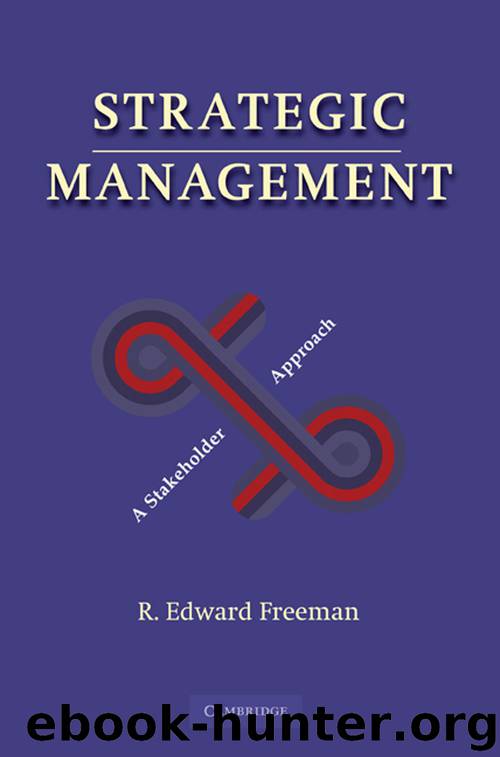Strategic Management: A Stakeholder Approach by R. Edward Freeman

Author:R. Edward Freeman
Language: eng
Format: mobi
Publisher: Cambridge University Press
Published: 2010-03-10T14:00:00+00:00
STAKEHOLDER ANALYSIS EXAMPLE: THE U.S. SUPERSONIC TRANSPORT
Background
In 1963, after much study, President Kennedy announced that the U.S. would build a supersonic transport airplane (SST) capable of transporting passengers at speeds of up to three times the speed of sound (Mach 3). Similar programs were underway in Europe with a consortium of British and French firms working on the Concorde, and in the Soviet Union working on what became the TU-144. The U.S. project was to be a joint initiative between government and private industry. The project managers from government were in the Federal Aviation Administration (FAA), and the key private actors were Boeing, Lockheed, G.E., Pratt and Whitney, etc. Initial attempts at design of the airplane were flawed and delayed for a variety of reasons. Funding for the program had to be secured through the Congress. The technology for building the SST was untested. Also, the FAA had been primarily an administrative regulatory agency and had little experience in managing contractor relationships. Such partnerships were normally handled in the airline industry with the Department of Defense. In 1964 President Johnson created a Presidential Advisory Committee (PAC) on the project, chaired by Secretary of Defense Robert McNamara. The PAC began to ask many questions about the feasibility of the program, which up until 1964 had been ignored or assumed to be not an issue.
Thus, The Department of Commerce and the Institute for Defense Analysis were called upon to make economic studies. The PAC met often and asked tough questions of the program managers and the contractors who were bidding on the final contracts. Indeed, by 1967 there was no agreed upon design for the plane and every deadline had been missed. In addition, by 1967 the sonic boom that the SST would produce became an issue and the National Academy of Sciences got involved in evaluating the effects of the boom, as did a special Sonic Boom Coordinating Committee of the Office of Science and Technology. Hence, the management of the program began to fragment, as new stakeholders emerged and as design issues were not yet solved.
The late 1960s saw the emergence of the environmental movement. The SST became a symbol of a technology which would do environmental harm and which was not really needed, at least according to the environmental critics, led by Dr. William Shurcliff, a physicist from Harvard. As a result of the internal focus of the project managers towards answering questions posed by PAC, the environmental critics were basically ignored and were ultimately victorious in killing the program in 1971.
Download
This site does not store any files on its server. We only index and link to content provided by other sites. Please contact the content providers to delete copyright contents if any and email us, we'll remove relevant links or contents immediately.
Tools of Titans by Timothy Ferriss(7813)
Change Your Questions, Change Your Life by Marilee Adams(7374)
Deep Work by Cal Newport(6563)
Man-made Catastrophes and Risk Information Concealment by Dmitry Chernov & Didier Sornette(5649)
Playing to Win_ How Strategy Really Works by A.G. Lafley & Roger L. Martin(5503)
Digital Minimalism by Cal Newport;(5389)
Big Magic: Creative Living Beyond Fear by Elizabeth Gilbert(5352)
The Slight Edge by Jeff Olson(5200)
The Motivation Myth by Jeff Haden(5004)
Ego Is the Enemy by Ryan Holiday(4957)
Stone's Rules by Roger Stone(4857)
The Laws of Human Nature by Robert Greene(4773)
Tuesdays with Morrie by Mitch Albom(4401)
Rising Strong by Brene Brown(4192)
Eat That Frog! by Brian Tracy(4149)
Skin in the Game by Nassim Nicholas Taleb(3966)
The Money Culture by Michael Lewis(3847)
Bullshit Jobs by David Graeber(3831)
Skin in the Game: Hidden Asymmetries in Daily Life by Nassim Nicholas Taleb(3723)
